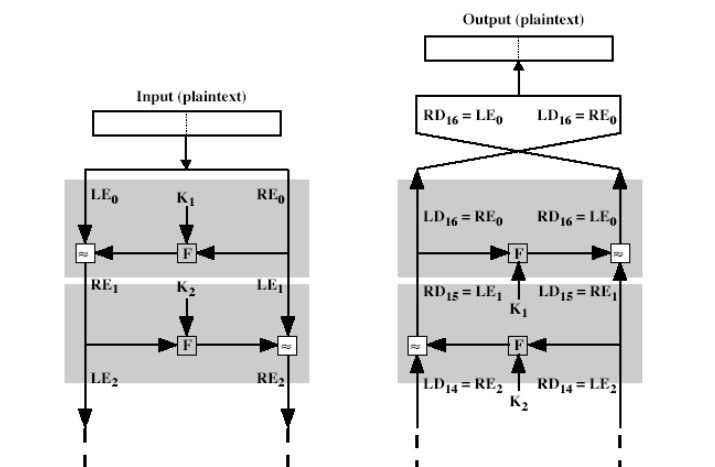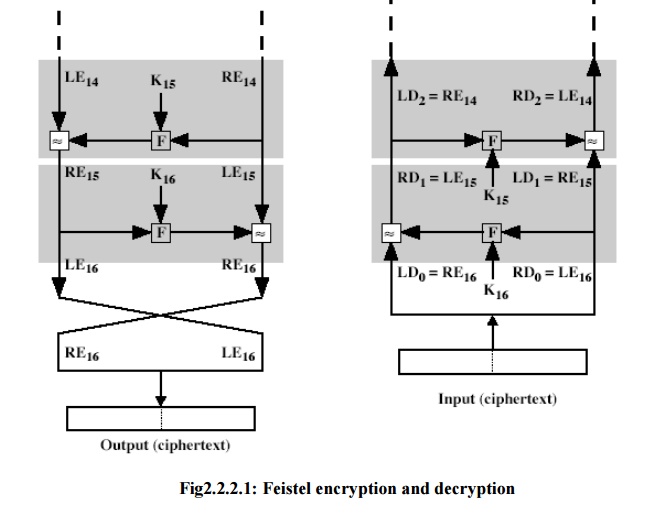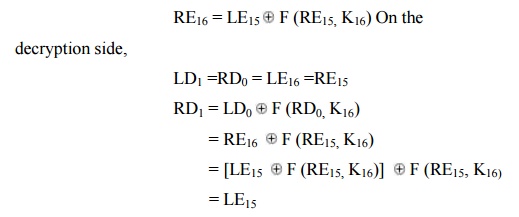Chapter: Cryptography and Network Security
Block Cipher Principles
BLOCK CIPHER PRINCIPLES
Virtually,
all symmetric block encryption algorithms in current use are based on a
structure referred to as Fiestel block cipher. For that reason, it is important
to examine the design principles of the Fiestel cipher. We begin with a comparison of stream cipher with block
cipher.
A stream cipher is one that encrypts a digital
data stream one bit or one byte at a time.
E.g, vigenere cipher. A block cipher
is one in which a block of plaintext is treated as a whole and used to produce
a cipher text block of equal length. Typically a block size of 64 or 128 bits
is used.
1 Block cipher principles
most
symmetric block ciphers are based on a Feistel
Cipher Structure
needed
since must be able to decrypt
ciphertext to recover messages efficiently
block
ciphers look like an extremely large substitution
would
need table of 264 entries for a 64-bit block
instead
create from smaller building blocks
using
idea of a product cipher in 1949 Claude Shannon introduced idea of substitution-permutation
(S-P) networks called modern substitution-transposition product cipher these
form the basis of modern block ciphers
S-P
networks are based on the two primitive cryptographic operations we have seen
before:
substitution (S-box)
permutation (P-box)
provide confusion and diffusion of message
diffusion – dissipates statistical structure of plaintext over bulk of
ciphertext
confusion – makes relationship between ciphertext and key as complex as
possible
2 Feistel cipher structure
The input
to the encryption algorithm are a plaintext block of length 2w bits and a key
K. the plaintext block is divided into two halves L0 and R0.
The two halves of the data pass through „n‟ rounds of processing and then
combine to produce the ciphertext block. Each round „i‟ has
inputs Li-1 and Ri-1, derived from the previous round, as
well as the subkey Ki, derived from the overall key K. in general,
the subkeys Ki are different from K and from each other.
All
rounds have the same structure. A substitution is performed on the left half of
the data (as similar to S-DES). This is done by applying a round function F to
the right half of the data and then taking the XOR of the output of that
function and the left half of the data. The round function has the same general
structure for each round but is parameterized by the round subkey ki.
Following this substitution, a permutation is performed that consists of the
interchange of the two halves of the data. This structure is a particular form
of the substitution-permutation network.
The exact
realization of a Feistel network depends on the choice of the following
parameters and design features:
Block size - Increasing size improves
security, but slows cipher
Key size - Increasing size improves
security, makes exhaustive key searching harder, but may slow cipher
Number of rounds - Increasing number improves
security, but slows cipher
Subkey generation - Greater
complexity can make analysis harder, but slows cipher
Round function - Greater complexity can make
analysis harder, but slows cipher
Fast software en/decryption & ease of analysis
- are more
recent concerns for practical use and
testing.
The
process of decryption is essentially the same as the encryption process. The
rule is as follows: use the cipher text as input to the algorithm, but use the
subkey ki in reverse order. i.e., kn in the first round,
kn-1 in second round and so on. For clarity, we use the notation LEi
and REi for data traveling through the decryption algorithm. The
diagram below indicates that, at each round, the intermediate value of the
decryption process is same (equal) to the corresponding value of the encryption
process with two halves of the value swapped.
i.e., REi
|| LEi (or) equivalently RD16-i || LD16-i
After the
last iteration of the encryption process, the two halves of the output are
swapped, so that the cipher text is RE16 || LE16. The
output of that round is the cipher text. Now take the cipher text and use it as
input to the same algorithm. The input to the first round is RE16 ||
LE16, which is equal to the 32-bit swap of the output of the
sixteenth round of the encryption process.


Now we
will see how the output of the first round of the decryption process is equal
to a 32-bit swap of the input to the sixteenth round of the encryption process.
First consider the encryption process,
LE16
= RE15

Therefore, LD1 = RE15 RD1
=
LE15
In
general, for the ith iteration of the encryption algorithm,
LEi
= REi-1

Finally, the output of the last round of the decryption process is RE0 || LE0. A 32-bit swap recovers the original plaintext.
Related Topics